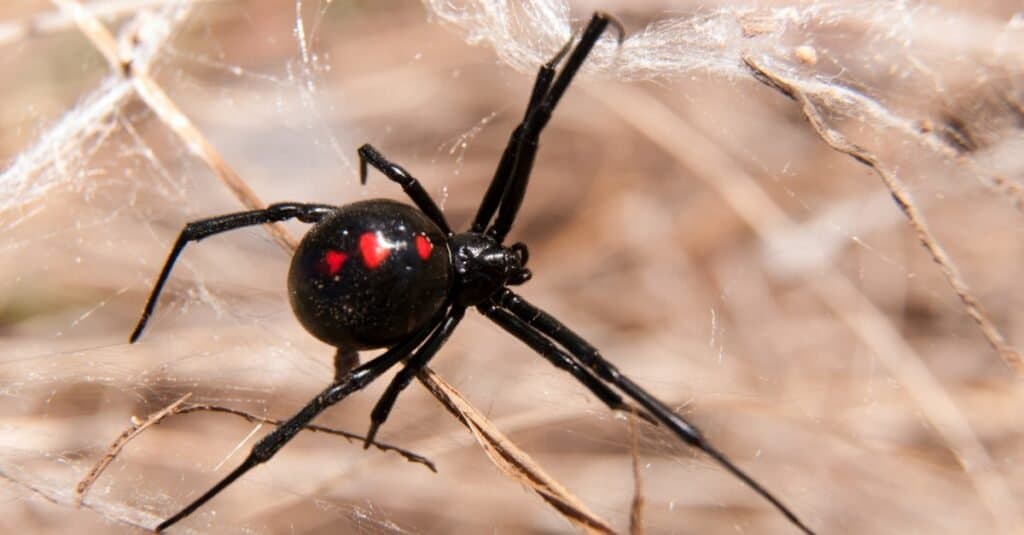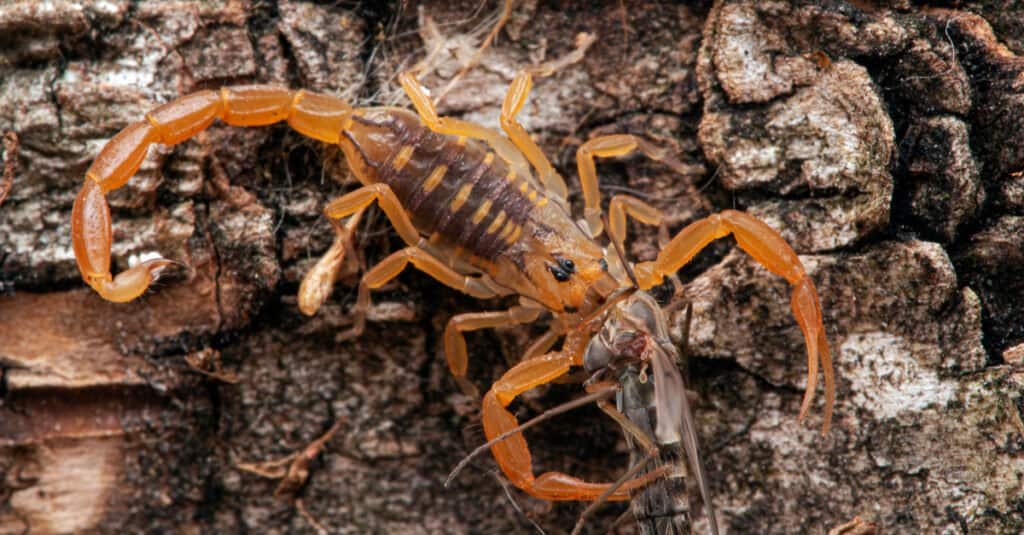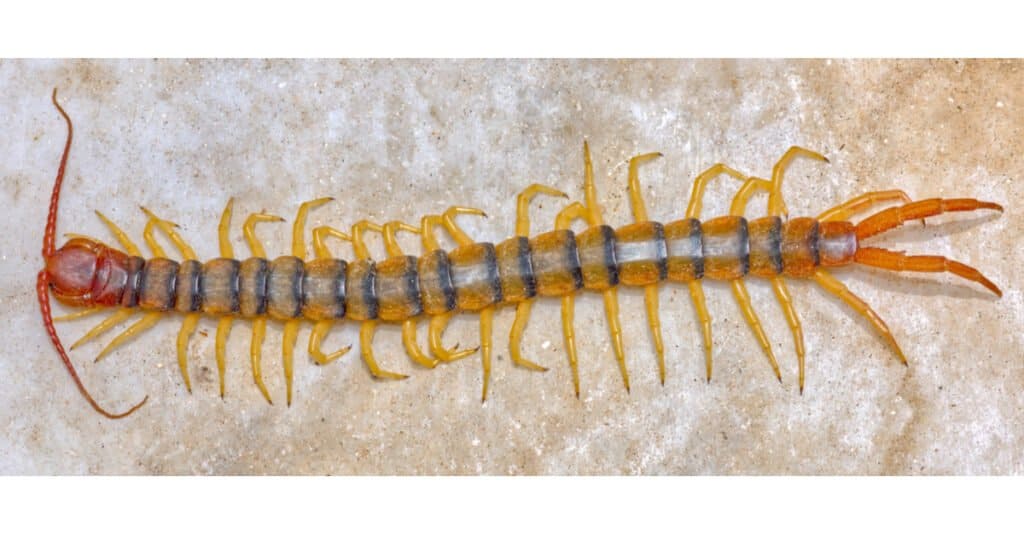Arizona is the only state that has all four North American deserts; the Sonoran, Mohave, Chihuahuan, and Great Basin deserts. So, when you think of deadly animals you may think of desert animals like snakes, scorpions, and spiders. These are dangerous animals in Arizona but have you heard of a venomous centipede that is 8 inches long! What about the intimidating 2-foot-long Gila monster? And there are large predators like black bears and mountain lions. These animals are all dangerous but are any of them deadly? Let’s find out about the deadliest animals in Arizona.
Dangerous (Poisonous) Snakes in Arizona

The ridge-nosed rattlesnake is the state snake of Arizona
©Matt Jeppson/Shutterstock.com
There are 13 varieties of rattlesnakes in Arizona with the state snake being the Arizona ridge-nosed rattlesnake, the ridge-nosed rattler is venomous, but they are a smaller snake growing to be around 18 inches. There have been no reports of fatalities due to bites from ridge-nosed rattlesnakes. There are 6 species of rattlesnakes in the Grand Canyon that hikers and campers need to be aware of: The Grand Canyon Pink, black-tailed, Great Basin, Hopi, Mojave, and speckled. The Arizona Poison centers report an average of 200 snake bites a year, but since not everyone reports bites, the actual number is estimated to be closer to 250-350. Even so, there are few deaths from venomous snakes, with no reported deaths in the Grand Canyon area. In fact, in the United States, there are typically only 5 deaths per year from the 7,000-8,000-bite average.
The last fatal snake bite in Arizona was in 2007 when a female was bitten by a Mojave rattlesnake in Paulden. Before that, a 35-year old male hiking near Wilcox was bitten in 2005 and passed away. There were three deaths from snakes in Arizona in the 2000s from snake bites but no reported deaths last decade.
What kind of dangerous spiders live in Arizona?

Black widows are the most dangerous spider in Arizona, but their bites rarely lead to death.
©Sari ONeal/Shutterstock.com
Even if it doesn’t make sense, if I found a spider in my tub I would much rather it not be a tiny, 1cm-long brown recluse spider than a five-inch-long furry tarantula! Both are venomous but the brown recluse spider bite is much more venomous and leaves behind an open sore that may take weeks to heal. Even more poisonous than brown recluses however are the black widows. Arizona has a healthy black widow population and not just in the desert. Due to the abundance of food sources in the cities, they are frequently cohabitating with humans. In the US, 2,500 black widow bites are reported annually. However, fatalities from black widow bites are extremely rare, with the last reported fatality in 1983. If you want to get rid of black widow spiders you can bring in one of their predator: the bark scorpion…which leads to the next dangerous animal in Arizona!
Deadly scorpions in Arizona

Arizona bark scorpions are one of the most common scorpions in the state.
©Ernie Cooper/Shutterstock.com
Arizona bark scorpions are another animal that you may encounter in cities as well as the desert. They can sneak into your home through a crack as small as a credit card. Once in they can scurry across your floor or climb your walls and hang from the ceiling (I know, this is not making you feel more comfortable). However, they are not out to get you and typically only bite if startled or provoked. Arizona does have the highest number of reported scorpion bites in the US with an annual average of 11,500 per year! According to the Mayo Clinic, very few deaths have been reported from scorpion bites. The Arizona Poison and Drug Information Center was instrumental in helping create an FDA-approved antivenom which helps treat scorpion bites.
Centipedes in Arizona: The 8-inch desert giant

Giant desert centipedes can reach 8 inches in length and are found in Arizona deserts.
©Deep Desert Photography/Shutterstock.com
Giant desert centipedes are the largest centipede found in Arizona. An 8-inch-long centipede may not even sound that intimidating until you see one next to a human arm. They are long a big, around a half-inch wide, and are orange and black with 42 legs. They have antenna on one end and pinchers on the other which are appendages that have venom in them, so they don’t actually bite their victims, they pinch them. Unless someone has an allergic reaction, they should be able to treat the “bite” at home but may need to seek medical attention if needed. It should be noted that while giant desert centipede stings are not fatal, they’ve been described as one of the most painful stings in the world. So be careful when around these giant centipedes!
Gila Monsters: The most deadly lizard in Arizona?

The Gila monster has incredibly painful bites but none have led to reported fatalities in Arizona.
©iStock.com/kwiktor
Anything with the name “Monster” in its title grants some respect, but these lizards typically stay away from humans. Gila monsters have skin that looks like it is made from small beads and can grow to be 2 feet and weigh up to 5lbs, with most of them being 18-22 inches and closer to 3-4 pounds. They are venomous but instead of taking a bite and running away they chomp down and hold on! Although painful, there are no reported deaths from Gila monster bites.
Black Bears
Black Bears are not dispersed throughout Arizona but there is a pocket of black bears just NE of Phoenix, their population totals about 3,000 bears in the state. Black bears are smaller than grizzly bears but can be just as dangerous in an attack. Luckily very few bear attacks occur in the United States, however there was an unfortunate case of an Arizona woman who was attacked while walking her dog at a country club in Pinetop, Arizona. She was airlifted to a nearby hospital and for four weeks was treated and underwent multiple surgeries, but the doctors think an infection eventually led to her death. This was the only fatality in Arizona from 1990-to 2011 and there were only six other bear attacks during that time period, so black bear attacks are extremely rare.
Mountain Lions
Mountain lions are about the same size as some of our larger dog breeds like Great Danes. Great Danes can grow to be 140-175lbs and Mountain lions weigh 130-150lbs, with some males reaching beyond 200lbs. In short, Great Danes are taller and mountain lions are longer. Their long sleek bodies can get to be 8ft.
You are actually more likely to be attacked by a dog (not Great Danes in general) than a mountain lion. In a recent study, there were 2,358 inpatient hospital visits and 34,151 Emergency Room visits in Arizona between 2008-2012 due to dog attacks/bites. That is an average of 472 people per year that have bites severe enough to require inpatient hospitalization. Mountain lions on the other hand have only been responsible for 6 attacks since 1988. According to a spokesperson from the Arizona Game and Fish in Tucson they receive 80-100 calls a year regarding mountain lion sightings but they rarely make contact with humans. One story out of the Sabino Canyon Recreation Area reported a couple woke up to find three mountain lions drinking out of their artesian well, they snapped a photo to share. They left the area a while later without incident. Clearly not just the neighbor cats passing by!
Bonus: What Keeps Scorpions Away?

Use of certain essential oils like peppermint can help deter scorpions from entering your home.
©rawf8/Shutterstock.com
One of a person’s worst nightmares is having a scorpion wind up in their home–especially the deadly kind! Of the dangerous Arizona animals we covered, the scorpion is one that’s among the most likely to find its way into your home and possibly cause problems. The best way to avoid getting stung by a scorpion is to try and prevent them from entering your house in the first place.
As scorpions can get into your house through holes and cracks, you can check for possible entryways with a flashlight. If the light gets through from the inside to the outside, you should fill that hole or crevice with an appropriate product.
Keeping your yard free of debris helps cut down on areas scorpions would gravitate to. Scorpions are also drawn to moisture, so you should keep areas around your home dry where leaks or puddles may occur. Caulking doors and windows is also a good strategy to keep them out.
Scorpions hate certain scents, especially cinnamon, so you can sprinkle it around the baseboards of your home to help deter them. Essential oils like lavender, peppermint, cedar, and cinnamon can also be used near potential entry points in your home to keep these pests away.
Summary of the Most Dangerous Animals in Arizona
| Rank | Animal |
|---|---|
| 1 | Rattlesnakes |
| 2 | Black widows |
| 3 | Bark Scorpions |
| 4 | Giant Desert Centipede |
| 5 | Gila Monsters |
| 6 | Black bears |
| 7 | Mountain lions |
The photo featured at the top of this post is © Scott Delony/Shutterstock.com
Thank you for reading! Have some feedback for us? Contact the AZ Animals editorial team.






